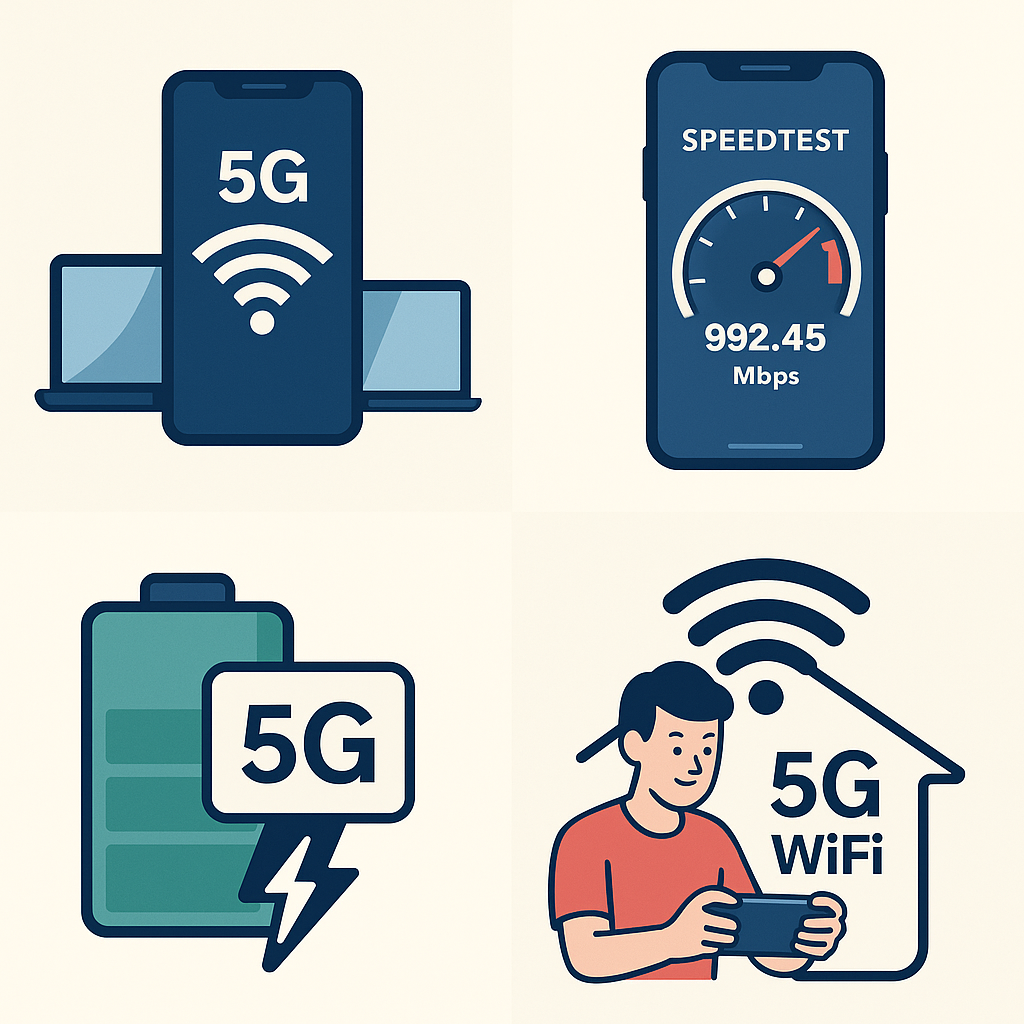
Why is 5G WiFi perfect for home use?
5G WiFi provides multi-gigabit speeds without the need for fiber to be run into your walls. A basic 5G router — sometimes not much bigger than a small speaker — comes with a cellular SIM card to connect to your local 5G network. You plug it in, connect your devices and you are online in minutes. Forget about trenching, no need for a cable technician or weeks of waiting for installation.
5G WiFi also leverages sophisticated antennae (massive MIMO and beamforming) to concentrate signals on your home. That’s stronger and more dependable coverage indoors — even in basements or rooms that are a very long distance from the router. Unlike legacy Wi-Fi, which can be bogged down when many devices are connected, 5G uses licensed spectrum to minimize interference from neighbors.
Cellular networks in many regions provide better backhaul (the connection from a cell tower to the internet) than wire or cable local service. If your broadband service is slow or flaky, 5G WiFi can easily match it or outstrip it. Carriers frequently provide unlimited data for home use, eliminating the data caps that are part of cable and satellite service.
Lastly, 5G WiFi routers are completely portable. Move to another house and bring your router, and you can keep the same IP address and plan; no need to change providers. For renters, vacation homes or temporary stays, 5G WiFi can be cheaper, as well as more flexible, than signing a one-year fiber contract.
How does 5G WiFi connect families and strengthen connectivity?
Modern families contend with streaming video, music and video calls, as well as smart-home devices including smart speakers, security cameras and gaming systems. One kid might be streaming 4K videos from YouTube while another plays an online game — while Mom jumps on a video call for work, and Dad relaxes in a corner and puts on music. The burden of traditional Wi-Fi can be heavy enough to creak underneath this load, with buffering, lags and dropped connections.
5G WiFi provides a strong answer. A well-spec’d 5G router can make this experience even better Since sub -6GHz and mmWave have channel widths that can go up to 400MHz, a realistically configured 5G router is able to provide 500 – 1000Mbit and above per devices. Low latency (<20 ms) means video calls are clear and gaming is lag free. Even with ten or twenty devices connected, though, advanced scheduling and beam-forming ensure that bandwidth is evenly distributed.
Many 5G plans are unlimited, so families no longer fret about overage fees. Parents can establish special SSIDs (fancy network names) for kids and guests, and can prioritize school-work devices during homework time. A band-steering feature automatically sends each device to the best frequency — 2.4 GHz for range, 5 GHz or 6 GHz for speed.
As home networks are overwhelmed by new gadgets (smart thermostats, doorbells, voice assistants), 5G WiFi technology changes the status quo to keep up. And once upgraded, it’s almost completely hands off; most routers self-update firmware over the air. Families can rest easy knowing their digital lives will continue uninterrupted.
What is the benefit of a 5G WiFi for a video call?
The quality of a video call is determined by smooth upload and download speeds and minimal lag. Household legacy broadband might have fast download, but low upload rates (10-20 Mbps) which leads to freezes when sharing your feed. 5G WiFi packages typically offer symmetrical or nearly symmetrical rates with uploads from 50 to 200 Mbps.
Low latency is key: 5G’s end-to-end delays can go lower than 20 ms, compared to 50 to 100 ms on previous networks. That snappier response time prevents problems like audio echo, lip-sync issues and delayed reactions to people’s statements, which can make convos awkward. Whatever your platform — Zoom, Teams, FaceTime — 5G WiFi helps ensure everyone is still “in the room.”
Many routers offer Quality of Service (QoS) settings that enable you to prioritize video-call traffic. Begin phone calls the router gives more bandwidth to your call to assure your Hd quality even with many people at home currently streaming. No more anxious scrambling to pause the kids’ movies while you’re on a work call.
5G WiFi is often still up and running when cables drop in stormy weather, under a backhoe, or where lines get overloaded because its access points use redundant cell sites and dynamic network routing. Your video calls pluck on cellular backhaul, no all-around blackouts or lost productivity.
When will all home routers be 5G WiFi capable?
Here’s the thing: Big router companies only started shipping 5G-ready models toward the end of 2021. Netgear’s Nighthawk M6, ASUS’s 4G-AX56 (with 5G upgrade) and Huawei’s 5G CPE Pro followed hot on its heels. In 2023, Linksys, TP-Link and D-Link did the same bringing to market their midrange 5G WiFi routers that cost between $200 and $350.
By 2024, chip makers such as Qualcomm and MediaTek built 5G modems into the mainstream Wi-Fi 6E platforms. That means nearly every new high-end router brings a slot for 5G or a built-in cellular radio. Optional USB-C 5G modems or mini-PCIe slots will also start appearing on entry-level brands in 2025.
Carrier partnerships tend to come before adoption. An increasing number of ISPs sell “5G Home Internet” plans as well, including compatible routers for free or as part of a discounted package. Many have sunset older fixed wireless 4G LTE boxes to embrace faster 5G models. Look for all midrange and premium routers, which are typically sold online and in stores, to be 5G-ready by 2026.
If you purchase a new router today, look for “5G NR” or “5G FWA” in the specs. Find support on your carrier’s bands: sub-6 GHz and mmWave (if available where you are). And even if you don’t need it now, a 5G slot future-proofs for when wired plans go down or usage surges.
Where should you place your 5G WiFi router?
Location is more important than you may realize. First, locate your router near a window that points toward the closest cell tower located outside your home. 5G signals travel poorly through brick or concrete, but glass and plastic don’t cause much attenuation. If you have a balcony or porch, try there first — signal bars on your cellphone can provide accuracy.
Do not use closets, basements, or interior rooms without windows. Even thick wood or drywall can reduce signal strength by 20–30dB. Do not put the router on the floor, mount it roughly 4-6 feet above the floor, on a shelf. That helps its antennas rise above furniture and aim beams at your devices.
Once you’ve identified a good window spot, use Ethernet or power-line extenders and step up to more potent Wi-Fi 6E access points in other parts of the house. This “hybrid” system leverages 5G for backhaul and wired links for local Wi-Fi, giving you the best of both “woofs.” Systems like Netgear Orbi or ASUS ZenWiFi can hang off LAN port to do the job of providing wireless coverage.
And lastly, stay away from appliances (microwaves, cordless phones) and large metal objects. They can reflect or absorb 5G and Wi-Fi signals. The line-of-sight to your living areas helps provide maximum throughput and reduces the risk of latency for your devices.
Is 5G WiFi better than 2.4 G?
Yes. During typical WiFi busy hours, one channel gets overrun, and collisions and retransmissions ensue when dozens of devices chatter. With 5G WiFi, it’s using licensed cellular spectrum, so there’s much less interference. Hacasbek, routers use OFDMA (orthogonal frequency-division multiple access) to sub-divides channels into sub-slots.
This allows the router to speak with multiple devices simultaneously rather than waiting for an open channel. Just picture the router throwing a dinner party: rather than serving one guest at a time, it serves appetizers to everyone all at once. That reduces waiting time and lets streams, calls and downloads continue uninterrupted.
Beamforming and massive MIMO go even farther. Instead of blasting signals in all directions, the router sends focused beams to each device. Each gadget has its own narrow beam, for boosted signal strength and minimized crosstalk. That’s right: Your laptop, phone, smart television and security camera can now all stream in high definition at the same time — and won’t slow one another down.
For very dense, heavily connected homes (20+ connected devices), pick a router tagged “Wi-Fi 6E” with 5G backhaul. They two support tri-band Wi-Fi (2.4 GHz, 5 GHz, 6 GHz), and can automatically allocate devices to the best band. In reality you will experience less interruptions, pauses and spinning buffers or disconnected calls when your home works at a busy pace to keep everyone online and connected in a 3,500 square foot home.
Which home plans have the 5G Wi-Fi?
Most major carriers have 5G Home Internet packages:
Verizon 5G Home Internet: Unlimited data, typical speeds 300–1,000 Mbps, $50/month.
T-Mobile Home Internet: Unlimited, 100–200 Mbps typical, $50 per month (with auto-pay).
AT&T Fixed Wireless: Unlimited, 75 to 500 Mbps, for $55 to 65/month.
Dish Network: Fixed 5G, 50 to 200 Mbps, $60 per month.
Regional and MVNO (mobile virtual network operators) carriers also offer prepaid or contract plans with 5G routers. Unlimited use costs $40 to $70 per month. Installation charges usually go down under promotional offers or when you trade in old gear.
5G home plans come with few data caps, but watch for “fair use”—some plans may slow speeds after an amount (say, 2 terabytes). Check out contract lengths, early-termination fees, and what hardware is included in warranties. Some plans come with free security suites, or add-ons like parental-control software.
If you’ve already got a smartphone plan on this same carrier, check to see if they offer bundle discounts. Family or business accounts can sometimes shave $5–$10 a month from your home internet bill. Read the fine print: equipment leasing fees and taxes can add about $5–$12/month on top of your base package.
Delves in How 5G WiFi Saves You Money?
5G Home Internet has the potential to beat cable and fiber on price and flexibility. Since there’s no installation trenching or drilling, you can save big going with Ring, while those outfitting their home with the services often charge an entrance fee of $100–$200. Routers are rented or sold for $0–$200, rather than buying proprietary gateway boxes.
Unlimited data is offered by many providers so overage fears are removed. Unlimited usage on high-speed traditional broadband plans have either extra usage charges or cap fees. Over one year, saving $10–$15 per month in overage charges is a savings of $120–$180.
Flexibility is also cheaper. If you cancel, move or switch plans with only a month notice — as opposed to a one-year contract — you don’t have the early-exit charges. For students, renters or travelers, 5G WiFi for short terms can be cheaper than paying deposits for wired services.
Lastly, convergence incentives are there for customers in both home and mobile services on the same account. Or, if you’re impatient, a $10–$20 bundle discount each month turns into a cumulative savings of $120–$240 in a year. For simplicity’s sake, one bill for all your connectivity also reduces billing headaches and the risk of late fees.
Why is 5G WiFi safer than public WiFi?
Public Wi-Fi hotspots — like those in cafes or airports — use unencrypted or weakly encrypted networks that hackers can easily access. At home with 5G WiFi, your data never leaves your private network behind carrier-grade firewalls and strong encryption (WPA3 on the Wi-Fi side, TLS on the cellular side).
And even if someone does get your Wi-Fi password, they can’t eavesdrop on traffic on the carrier backhaul. Carriers authenticate every SIM and create encryption keys on a per-session basis, so your information is safe from nosy neighbors. On the other hand, in the public hotspots they used the few encryption key is known to all users (shared).
Routers also allow you to segment your home network: You can create a guest SSID for visitors, isolate IoT gear on a separate VLAN and require strong passwords. Most consumer Wi-Fi hotspots don’t have these features, but many 5G WiFi gateways come with built-in intrusion detection, malware blocking and automatic security patching.
For telecommuting, VPNs over 5G WiFi give users an additional layer of safety. Because your home network is a private address space, your VPN tunnel is going to terminate in a known IP range, which you can more easily be more prescriptive about them accessing. Linus 5G WiFi at home = locked down, public access points just can’t compete.
When is the right time to change providers for 5G WiFi?
Consider switching if any one of the following applies:
You’re on a wired plan that’s too slow or capped. If you spend $60+/mo for 200 mbps and 5G promises you 500 – 1000mbps for the same price, time to switch.
There should be no excuse for installation delays. Time to move or same-day service? Get online in no time with 5G WiFi.
You face frequent outages. A storm or a cable cut or overtaxed lines won’t take down cellular backhaul.
You need symmetric speeds. Fixed broadband often lags for heavy uploads (cloud backups, livestreaming).
So you don’t lose all your flexibility in the short-term. No deposits, no 12-month lock-in — great for renters or condensed living.
Before you switch, look up coverage maps and read recent speed tests near you. Simply ask friends or neighbors on that same network about the real-world performance. Confirm that router has carrier bands. Look for bundle: if you already subscribe to mobile service with the same provider, you may receive an additional $5–$15 off your monthly bill.







